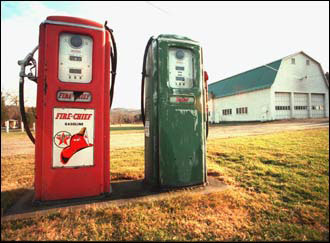
Trucks at Gas Station
Opponents of cash-for-clunkers bills, including the compromise bill negotiated yesterday, often complain that energy is wasted in manufacturing a new car to replace one that hasn't reached the end of its life yet. Fair point, right?
The generally accepted rule is that 10 to 12 percent of a vehicle's total lifetime energy usage is in its manufacture, assuming a lifetime of 10 years or more. (The mean age of US vehicles is now at 15 years.) In greenhouse-gas impact, that's about 7 tons of carbon dioxide--or the equivalent of 700 gallons of gas.
So, the Duke University researchers at The MPG Illusion asked how much better the mileage would have to be in a new car to offset the energy used to build it.
Their answer was, roughly, that the new vehicle should save at least 1 gallon of gasoline every 100 miles (which they call 1 GPM) to balance out the energy used to built it after 70,000 miles of driving. Once mileage passes 70,000 (in 4 to 7 years, they suggest), the car becomes a net energy saver.
Because MPG is not a linear scale, this means that improving from 18 to 22 mpg saves 1 gallon every 100 mile, but to save that same gallon starting with a 25-mpg car requires raising mileage to 33 mpg.
The compromise requires that all cars traded in get 18 miles per gallon or less, and they must be replaced with cars achieving 22 mpg or more. The highest incentive of $4,500 is only granted if the new car gets at least 10 mpg more than the old one (and at least 22 mpg). This encourages much greater gas savings.
The MPG Illusion team's conclusion: The rules set out in yesterday's compromise proposal largely achieve the 1 GPM principle for cars and light trucks; however, it fails to achieve the 1 GPM for large light trucks.
It's worth noting that the US clunkers bill has two somewhat contradictory goals: Saving energy, yes, but also kickstarting vehicle sales to assist a struggling auto industry whose sales have plummeted 30 percent in less than a year, to levels not seen in 30 years or more.
In this case, we suspect, the regulators had to balance more aggressive mileage requirements against making the program as widely applicable as possible to achieve its goal of up to 1 million vehicles traded in.
Meanwhile, car collector groups continue to rail against clunker bills, but this one may be a done deal. And just to repeat: It's voluntary, folks. You can continue driving your old car as long as you want, assuming it passes state inspection. Honest.

Gas Pumps
[SOURCE: MPG Illusion]













